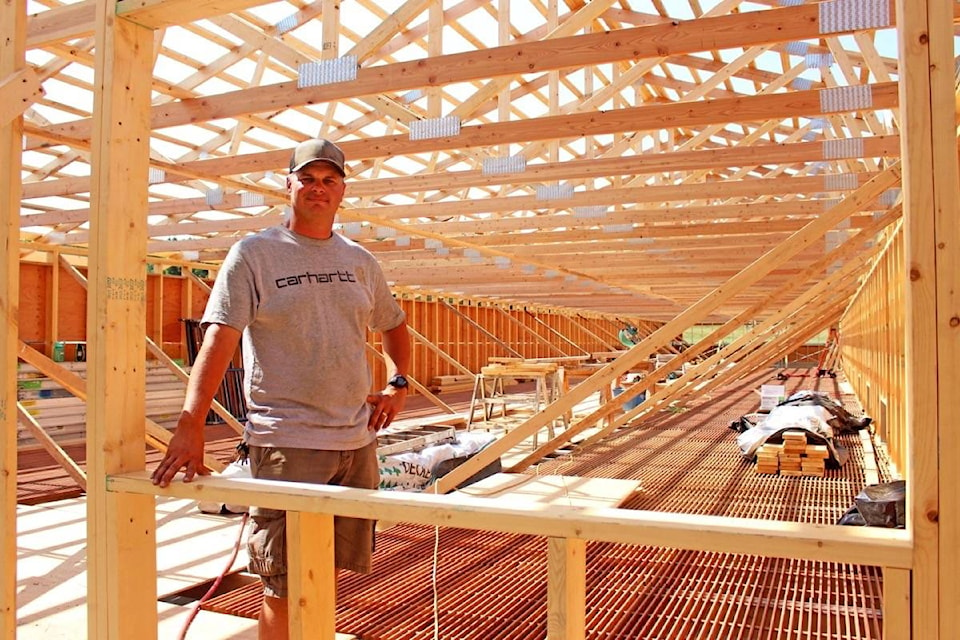In an effort to be more ag-transparent — or egg-transparent — Springford Farm is in the process of building a new free-range egg barn.
The Nanoose Bay farm will be home to a free-range egg barn, said Ross Springford who now owns the land the new barn is situated on.
Springford said the farm distributes eggs all over the Parksville Qualicum Beach region, and a lot of the time people ask if their free-range chickens really do go outside.
And starting next year, Springford said, people can come and have a look.
The barn, Springford said, will hopefully be open to the public in spring of 2018, but the whole process has been a few years in the making.
Springford, whose family moved to the Nanoose Bay location in 1998, said an opportunity came up a few years ago for new entrants into the egg farm industry.
Springford and his wife Erin submitted a business plan into the BC Egg Marketing Board in 2016 for a random draw. The application, he said, was then adjudicated to make sure the applicants can get land and follow through with the plan.
In 2017, Springford said, they were selected in the random draw and construction began this year. Springford added that there were only 11 applicants drawn in 2017, and the Springfords were the only applicants chosen on the Island that year.
“It’s not a process where it just kind of happens overnight.”
In order to be eligible for the funding, Springford said, he and his wife needed to have their egg-barn operation on a separate title of land. He said they have now taken ownership from his parents, Colin and Diane, for the land the barn will be on.
The Springfords aren’t new to free-range egg barns, though.
Springford’s parents, Colin and Diane, have their own free-range egg barn at the Nanoose Bay location. But, Springford said, because of biosecurity, the public isn’t allowed to go and see the day-to-day operations of his parents’ barn.
“Biosecurity is a term for basically maintaining high health in your flock.”
Springford said people coming into his parents egg barn have to wear “almost a hazmat-type suit.”
The new free-range egg barn will allow the public to see what goes on behind the scenes, Springford said.
“A lot of our friends and a lot of people we know, they’re like, ‘You’ve got a free-range egg barn. How does that work? What does that look like?’” Springford said. “One of the things we wanted to do was be able to show people what we do and how, basically their food is produced.
“We wanted to have a fully functional barn at a scale that is significant enough that people can get the concept of what we do, representative of (other barns on the farm),” he said.
Springford said the goal is to have the barn ready for the public by the spring of 2019.
He said the plan is to have the barn open to the public as the same hours as the store which is open Thursday to Sunday. The barn, Springford said, will be self-guided.
“If they go in (to the barn) and like what they see, conceptually, they could buy the eggs and take them home and eat them.”
The days the barn isn’t open to the public, Springford said they could open it up to school children.
It also helps that Erin is a teacher, said Springford, adding that there will be an educational aspect to the egg barn. Springford said the tours for children could be a little bit more in-depth.
But the biggest piece of the new barn is transparency, he said.
“We call it ag-transparency, like agriculture, but it could be egg-transparency too — depending on how fast you say it,” Springford said. “We want to convey to the consumers, in essence, what they’re buying.”
It might not be for everyone, though, Springford said.
“A t the end of the day, we can only show them what we can do, and we hope that it’s of high enough quality that we win people over.”
The new barn will house about 3,000 free-range chickens, compared to the original egg barn that houses about 9,000 chickens, Springford said.
Adjacent to the barn will be the pasture where the chickens will be free to roam.
Springford said he’s seeing a “huge change” from caged production to free-run and free-range chickens.
He said the new barn will be about 5,400 sq.-ft. and will include the viewing area, a separate entrance for farmers to do their work, and the area for the chickens.
There are also plans, Springford said, for solar panels and in-floor heating for the chickens.
Springford said thinking outside the box on this project will help to make the barn more economically and environmentally sustainable as time goes on.
